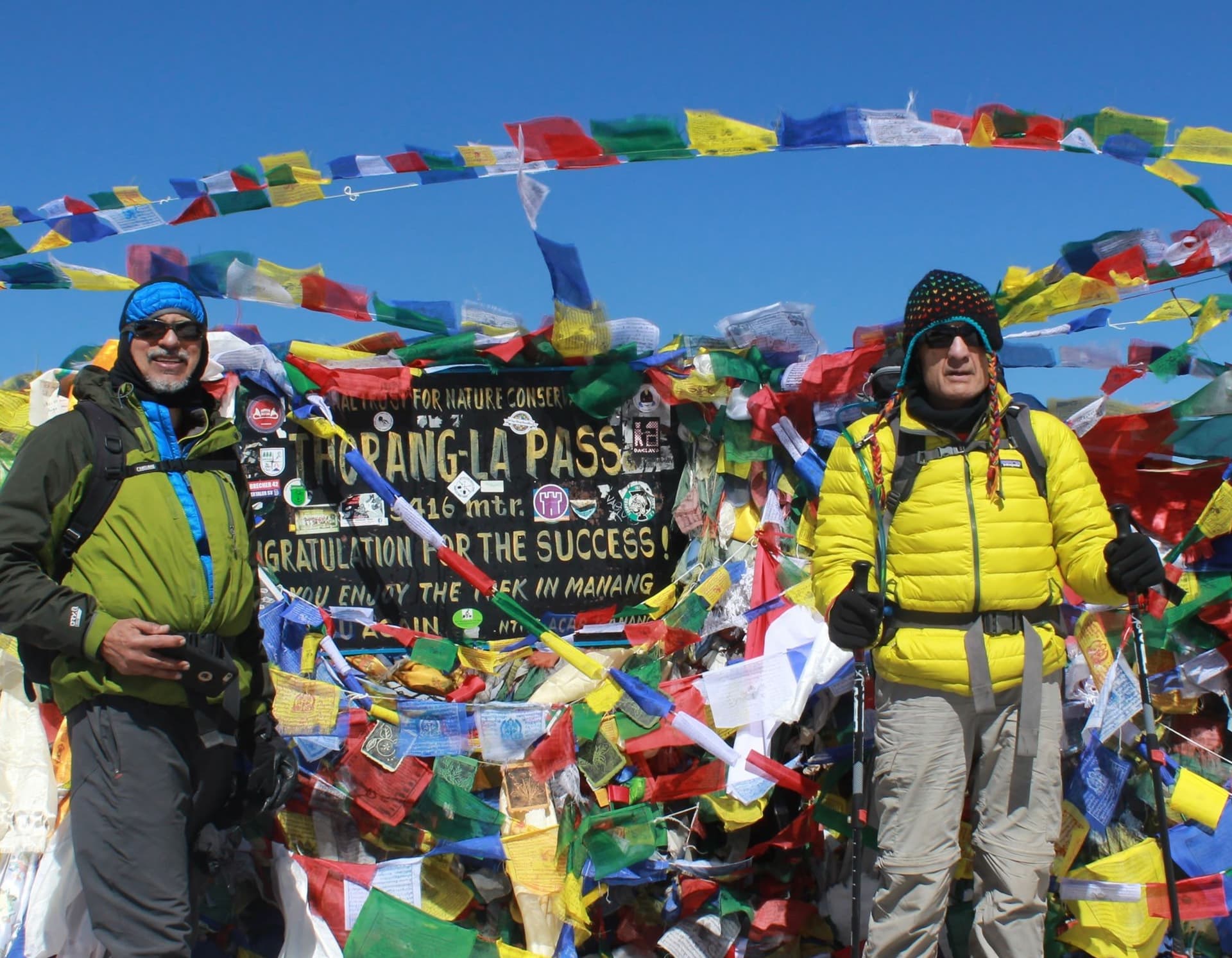Nepal is one of the best destinations for adventurous vacations. It is home of many of the tallest mountain peaks on Earth. As a matter of fact, eight of the ten tallest mountain peaks in the world are situated in Nepal, including Mount Everest- the highest peak on the planet. Nepal truly is a wonderful destination that presents many attractions and natural beauties. It is a country of many cultures and combined with the natural attributes, Nepal presents its visitors with unforgettable trekking and climbing adventures.
Likewise, another notable feature of Nepal is its topographical diversity. In just a span of (200 km) from north to south, Nepal has a biodiversity that harbors unique multifarious wildlife spheres- housing many different species of floral and faunal life pertaining to the terrain. Retrospectively, Nepal has numerous peaks that are suitable for climbing as well. In correspondence, Nepal is one of the best destinations for peak climbing in the world. Many enthusiastic trekkers and mountaineers from all across the globe visit Nepal for peak climbing adventures.
As such, Nepal Mountaineering Association (NMA) is granted the authority by the Mountaineering Section of the Ministry of Culture, Tourism and Civil Aviation (MoCTCA) to issue peak climbing permits in Nepal. So, what exactly is peak climbing? To answer that question in the most simplest of forms- peak climbing is carefully navigating your way to the summit of a climbable peak. In general, peak climbing, initially, follows the same basic routes of a typical base camp trekking. However, the point where peak climbing differs from base camp trekking lies in the fact that base camp trekking ends when, as the name itself suggests, the base camp of a peak is reached; peak climbing, on the other hand, takes the base camp trekking journey a bit further and has the final destination of the journey not on the base camp, but rather at the summit of the peak. As such, peak climbing is technically more difficult than base camp trekking. It requires a higher level of physical strength and strategy to overcome, along with the use of climbing gears as well- like ropes, crampons, harnesses and karabiners.
Nepal has many climbable peaks to choose from. Currently, there are about 326 climbable peaks in Nepal. However, amongst the many climbing peaks in Nepal, the Mera Peak is the most famous. Mera Peak trekking and climbing is one of the most sought-after peak climbing adventures in the country.
Mera Peak is part of the Mahalangur Himalayan range. It is situated in the Khumbu district of Nepal- home of Mount Everest. Mera Peak has an altitude of 6,476 meters and comparatively, it is one of the smaller trekking summits in the country. However, Mera Peak holds the title of Nepal's highest climbing peak. Due to Mera Peak presenting a rather less difficult climbing adventure than other climbing-peaks, Mera Peak is also suitable for first-time peak climbers.
Mera Peak Trekking and Climbing- Facts and Figures
Mera Peak trekking and climbing begins from Lukla. Along the journey, you go through various settlements and ethnic villages of the Khumbu, navigating your way through the off-beaten-trails at the Hinku valley. In general, the Mera Peak trekking and climbing takes about 19 days to complete. It begins with a short flight from Kathmandu to Lukla, from where the trekking trails then goes on to destinations like Paiya, Thaknak and Khare among many others. From the summit of Mera Peak, views of its neighboring Himalayas are quite breath-taking. The sight of peaks like the Lhotse, Everest, Makalu, Cho Oyu, Kanchenjunga and many others greet the trekkers from the summit. The trouble and effort of reaching the summit of Mera Peak is definitely worth the effort for the other-worldly view alone. There is nothing quite like the sight of the vast expanse of snow and ice on all directions with the glacial Himalayas towering above the river valleys.
Exact Location of Mount Mera Peak: Where is Mt. Mera
- Continent: Asia
- Country: Nepal
- Mountain Range: Himalayas (Mahalangur Section, Barun Sub-section)
- Region: Sagarmatha Zone, Sankhuwasabha District
- Exact Location: Near the Makalu Barun National Park, east of the Everest region
- Coordinates: 27°42′30″N 86°54′40″E
- Distance from Mount Everest: Approximately 20 km (12.4 miles) south of Everest
Mera Peak is a popular trekking peak, known for its relatively non-technical ascent and breathtaking views of Everest, Lhotse, Makalu, Cho Oyu, and Kangchenjunga.
Mera Peak lies southeast of Mount Everest, approximately 20 km (12.4 miles) away. It is often mistaken for a higher peak due to past mapping errors, but its actual height makes it one of the best non-technical trekking peaks in Nepal. The peak’s exact GPS coordinates are 27°42′30″N 86°54′40″E.
What is the Height of Mera Peak?
Mera Peak is one of Nepal’s most famous trekking peaks, standing tall in the Mahalangur section of the Himalayas. It consists of three main summits, each with a slightly different elevation. Many trekkers and climbers are often confused about its actual height due to past mapping errors, but the officially recognized elevations are as follows:
Mera Peak Summit Heights
| Summit Name | Height in Meters (m) | Height in Feet (ft) | Remarks |
|---|---|---|---|
| Mera North | 6,476 m | 21,247 ft | Highest and most commonly climbed summit |
| Mera Central | 6,461 m | 21,198 ft | Alternative summit, slightly lower than the north |
| Mera South | 6,065 m | 19,898 ft | Smallest among the three, offers different climbing route |
Understanding Mera Peak’s Heights
Mera Peak is frequently mistaken for being 6,654 meters (21,831 feet) due to historical mapping errors, where it was confused with Peak 41, a different mountain. The highest official point of Mera Peak is Mera North at 6,476 meters (21,247 feet). Despite the variations in height between the three summits, Mera North remains the primary objective for most climbers, as it offers the best panoramic views of Everest, Lhotse, Makalu, Cho Oyu, and Kangchenjunga.
Which Summit is the "Real" Mera Peak?
While all three summits are part of Mera Peak, the most frequently climbed and recognized summit is Mera North. However, some expeditions also climb Mera Central as an alternative route. Mera South, being the lowest, is less frequently climbed but offers a unique approach.
Why Does Mera Peak Have Multiple Heights?
The variation in summit heights is due to the mountain’s complex glacial structure, which results in multiple distinct peaks rather than a single sharp summit. This is common in the Himalayas, where many peaks have multiple high points that are part of the same massif.
How difficult is Mera Peak climbing?
Mera Peak trekking and climbing is a strenuous journey. You will need to prepare for a significant time prior to the climbing adventure. The trekking and climbing journey has many consecutive days where you will be trekking for more than 4 to 5 hours as you make your way from one destination to the next. As such, in order to keep up with the adventure, you will need a good physical strength and stamina. It is important to train your body for the journey. Doing regular cardio exercises, like running, jogging and swimming, can help in maintaining and booting the body's physical strength and help during the journey.
How long does it take to climb Mera Peak?
The Mera Peak trekking and climbing has a significant destination from where the climb to the summit begins to gradually start in the course of the journey. Typically, it starts at the village of Khare, where you will pass along glaciers and a mountain pass to spend the night at tents under the stars surrounded by snow. Then, from here, you slowly make your way to Mera High camp, which is situated at an altitude of 5,780 meters. From Khare, it takes about 6 to 7 hours of ascending uphill to reach the Mera High camp where usually, you will have an overnight stay. The trek is blessed with amazing panoramic views of peaks like Chamlang, Makalu and Baruntse among others. Furthermore, from High Camp, you will then make your way to the summit of Mera Peak. Ascending from High Camp all the way to the summit and the descend takes about 8 hours in total. You will wake up at 2 in the morning, and with the help of your climbing guide and equipments like ropes and crampons, you will climb up the summit, which in average, takes about 4 hours. Likewise, the descend back down is also equally as thrilling as the climb.
How do you train for Mera Peak climbing?
It is important to prioritize your training efforts in order to do the Mera peak trekking climbing adventure. The journey encapsulates ascending to high altitudes on continuous days with load on your back. Thus, the journey requires a combination of different methods of training your body for endurance. Exercises like aerobics training are one of the methods to use for body training. Cardiovascular exercises, in other words, are a must for the trek-and-climb preparation. The cardiovascular training is aimed at helping you cope with the high altitude conditions where the oxygen concentration is low. Aerobics training improves your heart's, lung's and blood cell's ability to adapt to these conditions. You can opt to train on treadmills with loads on your back as well, and then gradually increase the length and weight.
Best Time for Mera Peak
The best time for Mera peak trekking and climbing is during the spring and autumn seasons, which last from March to May and September to November respectively. It is not ideal to do Mera Peak climbing during the summer or winter seasons due to various inconveniences that may occur, like flight cancellations, blocked paths, muddy trails and others.
Mera Peak History – From Early Explorers to Record-Breaking Climbs
Mera Peak has seen it all—early explorers, daring first ascents, and record-breaking feats. It’s not just another trekking peak in Nepal; it’s a mountain with stories.
The First Explorers
Back in the 1950s, before Everest became the ultimate prize, British mountaineers roamed this region, mapping the unknown. Edmund Hillary, Tenzing Norgay, Eric Shipton, and George Lowe were among the first to step foot here. They weren’t aiming for Mera, but they saw it. They knew it was there.
The First Ascent of Mera Peak
The first recorded ascent of Mera Central (6,461m) happened on May 20, 1953. Col. Jimmy Roberts and Sen Tenzing made it to the top. Roberts wasn’t just another climber—he later helped open Nepal to trekkers, shaping the trekking industry as we know it. The government honored him posthumously in 2005.
Who Really Climbed Mera North First?
Mera North, the highest point (6,476m), has a bit of mystery. Some say French climbers Marcel Jolly, G. Baus, and L. Honills got there first in 1975. Others believe L. Limarques, Ang Lhakpa, and two Sherpas reached the top on October 29, 1973. Either way, the peak had its moment.
The Southwest Pillar – A Route Few Dare to Try
Fast forward to 1986. Mal Duff and Ian Tattersall took on the Southwest Pillar, an intense 1,800m vertical climb, dodging seracs and facing the elements. This was no simple trekking route—this was a serious Himalayan challenge.
Breaking Barriers – Hari Budha Magar’s Historic Climb
Mera Peak isn’t just about climbers with all their limbs. In 2017, Hari Budha Magar, a double above-knee amputee, climbed past 6,000m, proving that limits are only in the mind. His ascent made history, inspiring thousands.
The Strangest Summit Record – A Gym at 6,476m
Not all records are about climbing. On May 6, 2024, a team from Cyprus decided to set a Guinness World Record for the highest altitude fitness session. Led by Alexis Economides, they did squats, planks, and pushups at the summit. If suffering at altitude wasn’t enough, they made it a workout.
In conclusion, Mera Peak trekking and climbing is a beautiful journey that tests your endurance in the mountains with amazing rewards and a profound sense of accomplishment. It is a wondrous journey that will forever stay in your minds for years.



